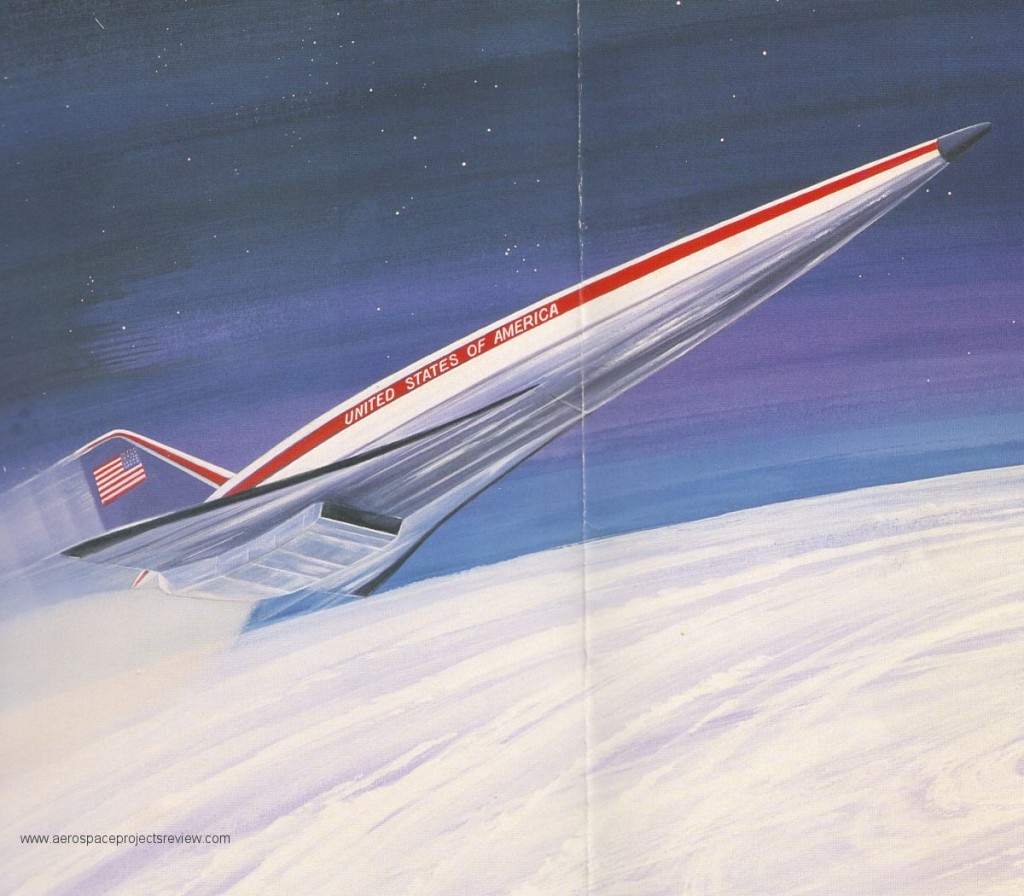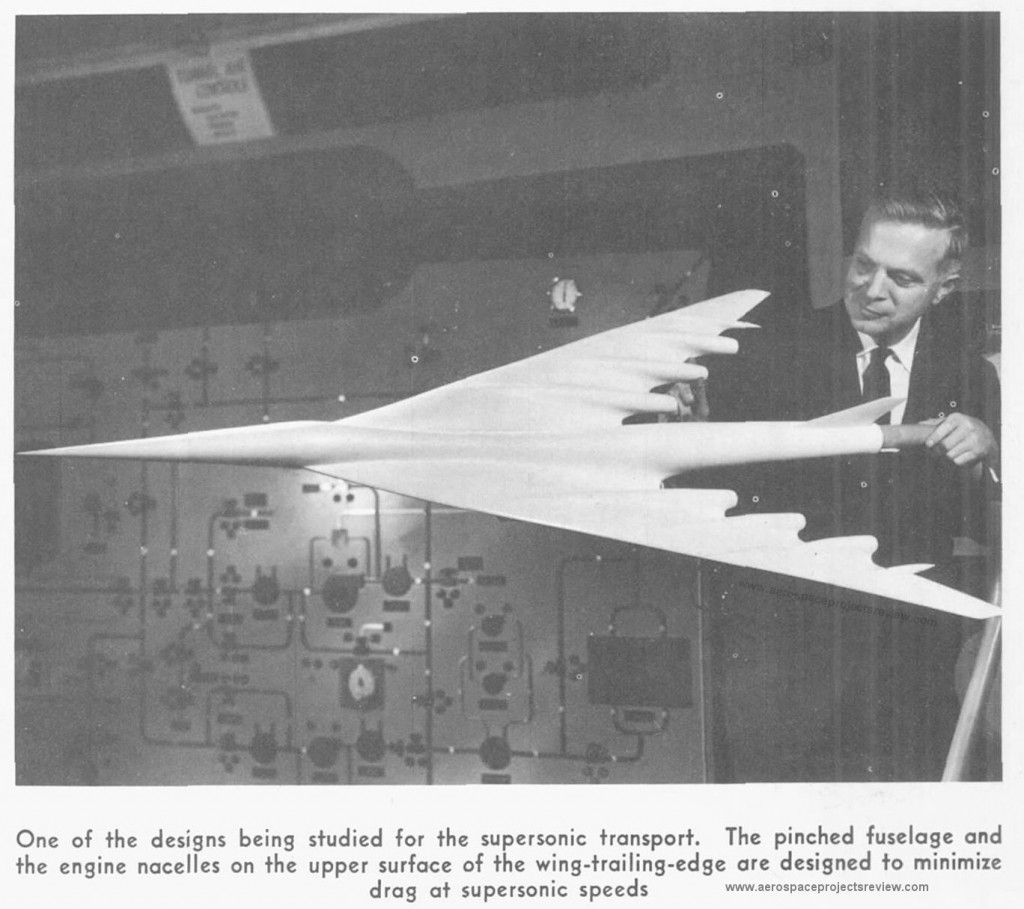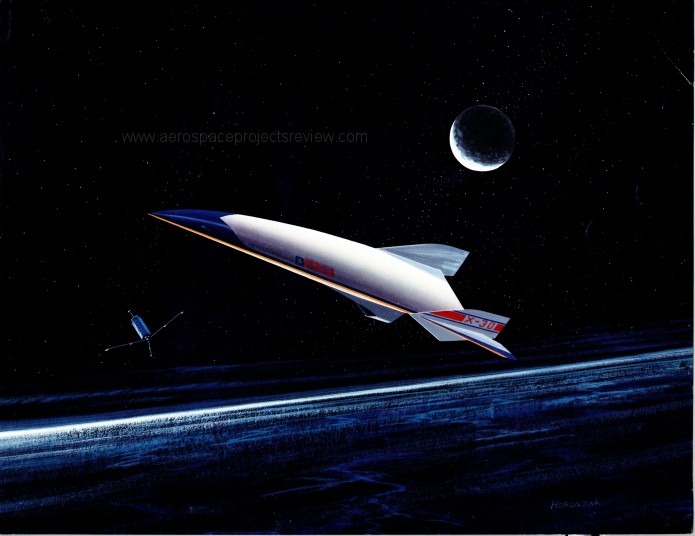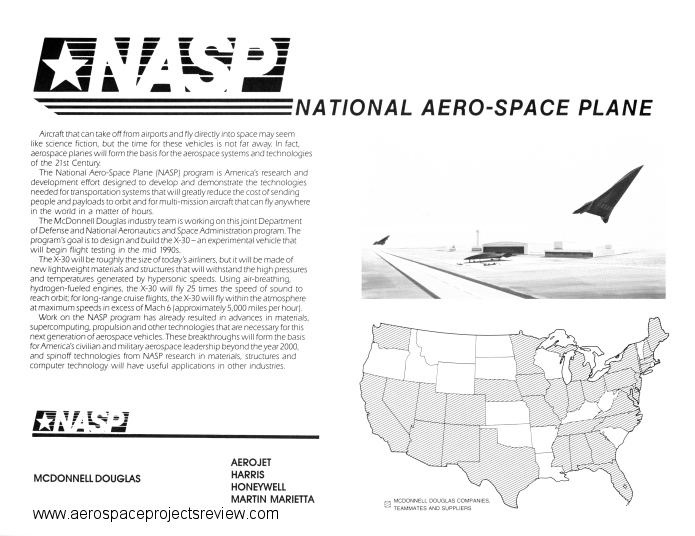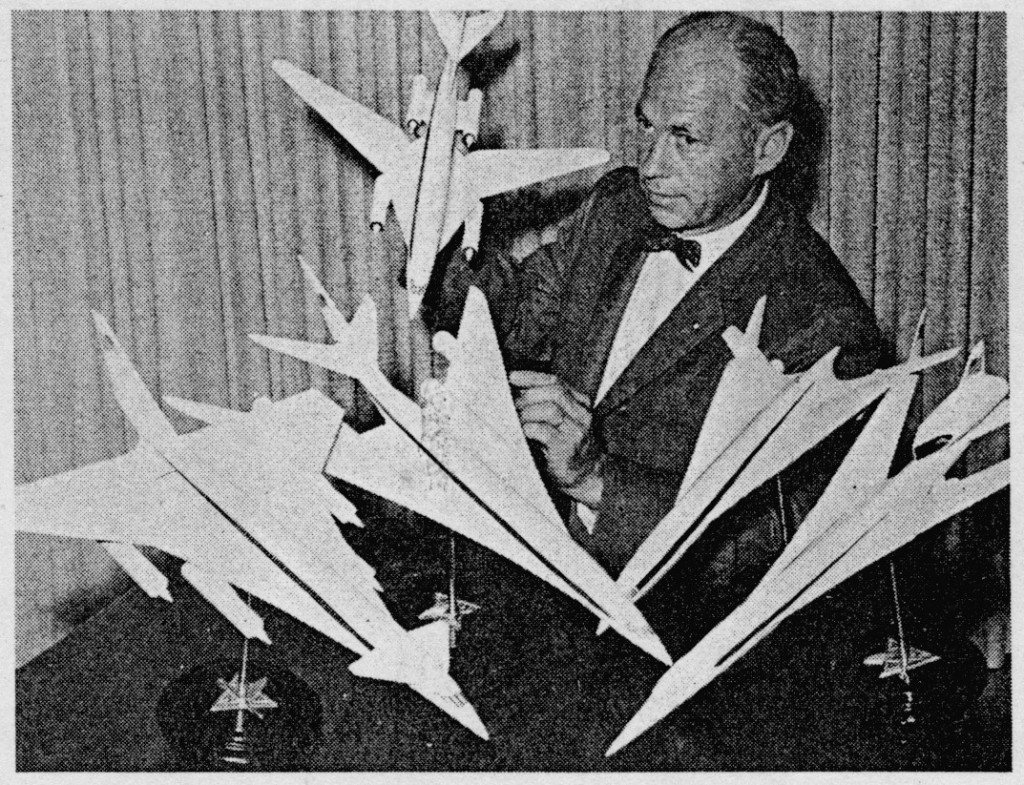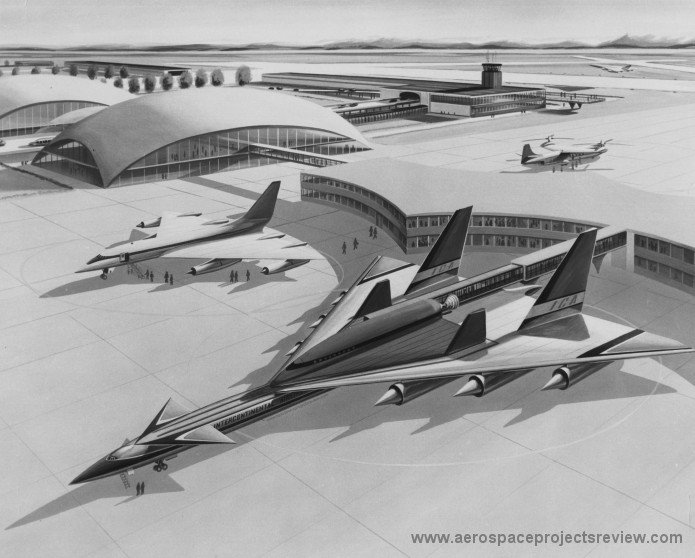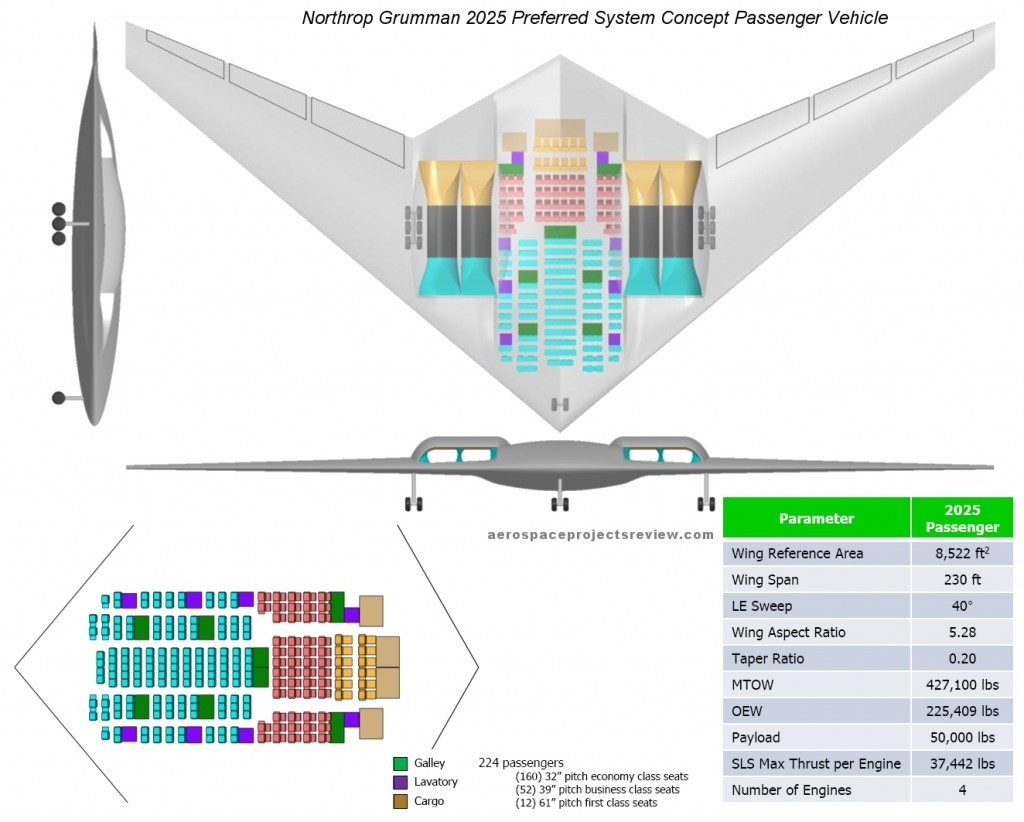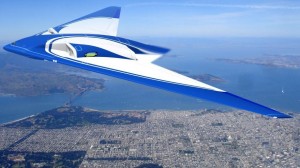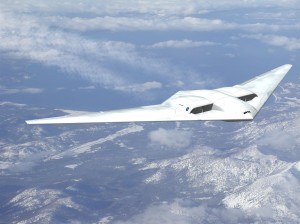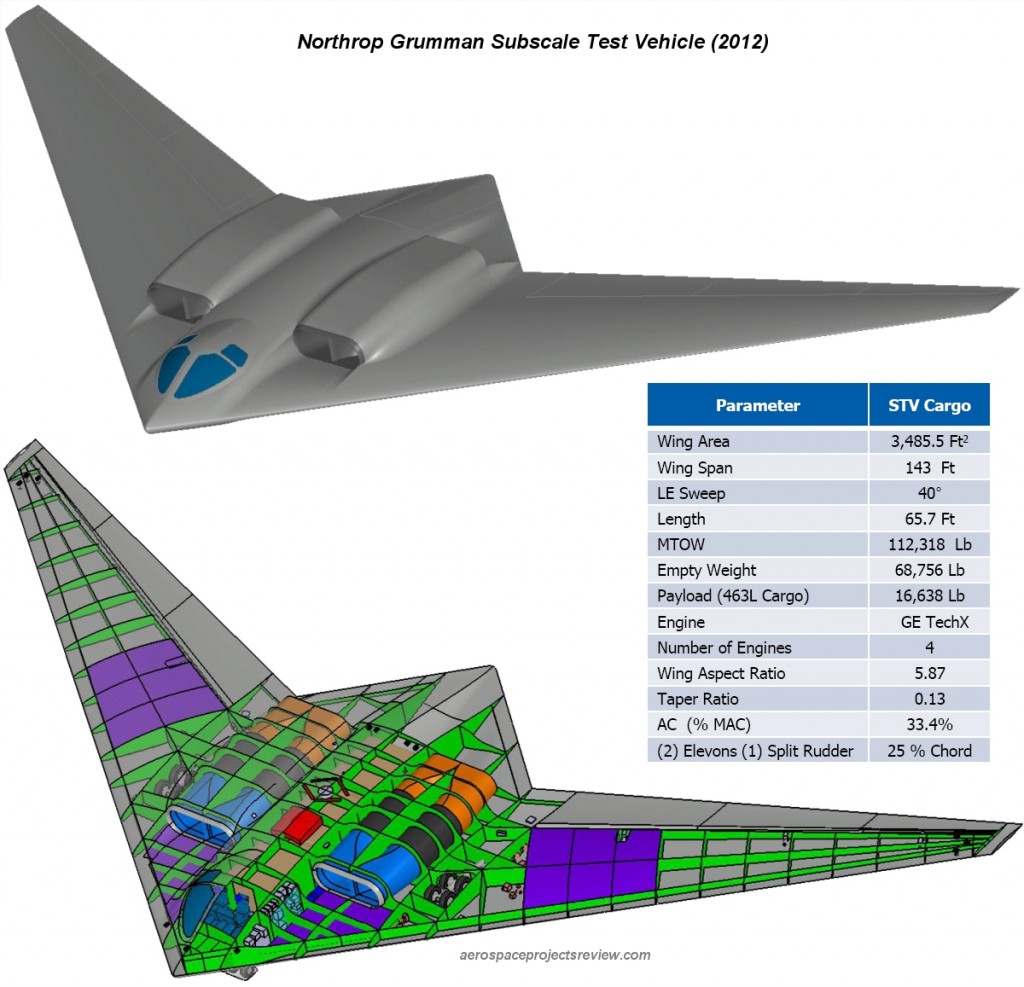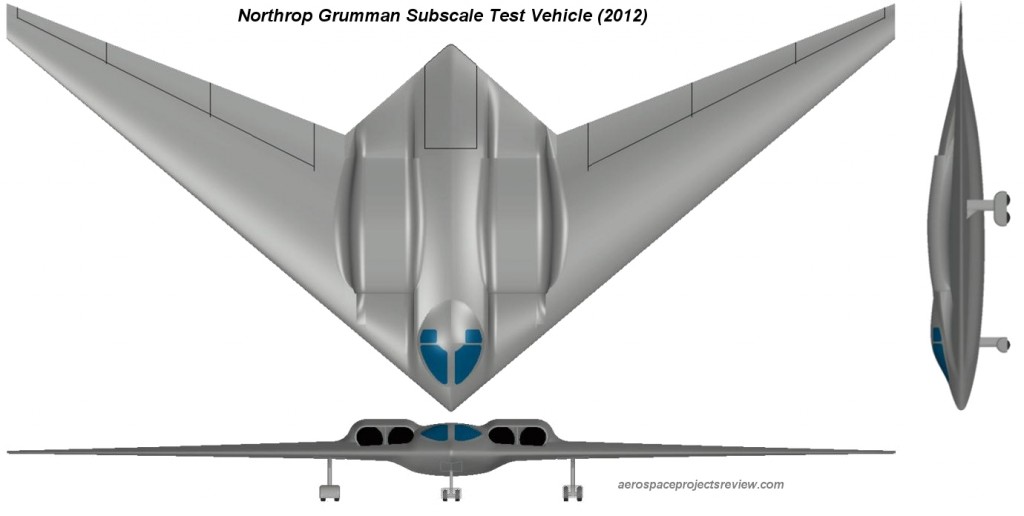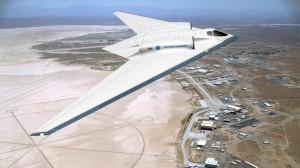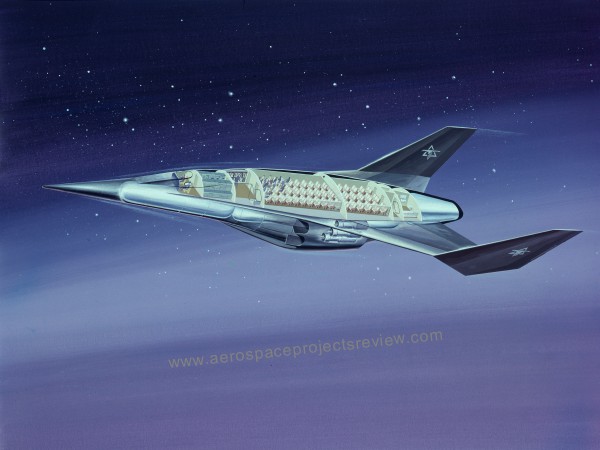An artists impression of one of the fairly vast number of SST designs put forward by Boeing under the designation “733,” which predated the “2707” designation. This one features angular delta wings and delta canards… and apparently no passenger windows. Dates from the early 1960’s.
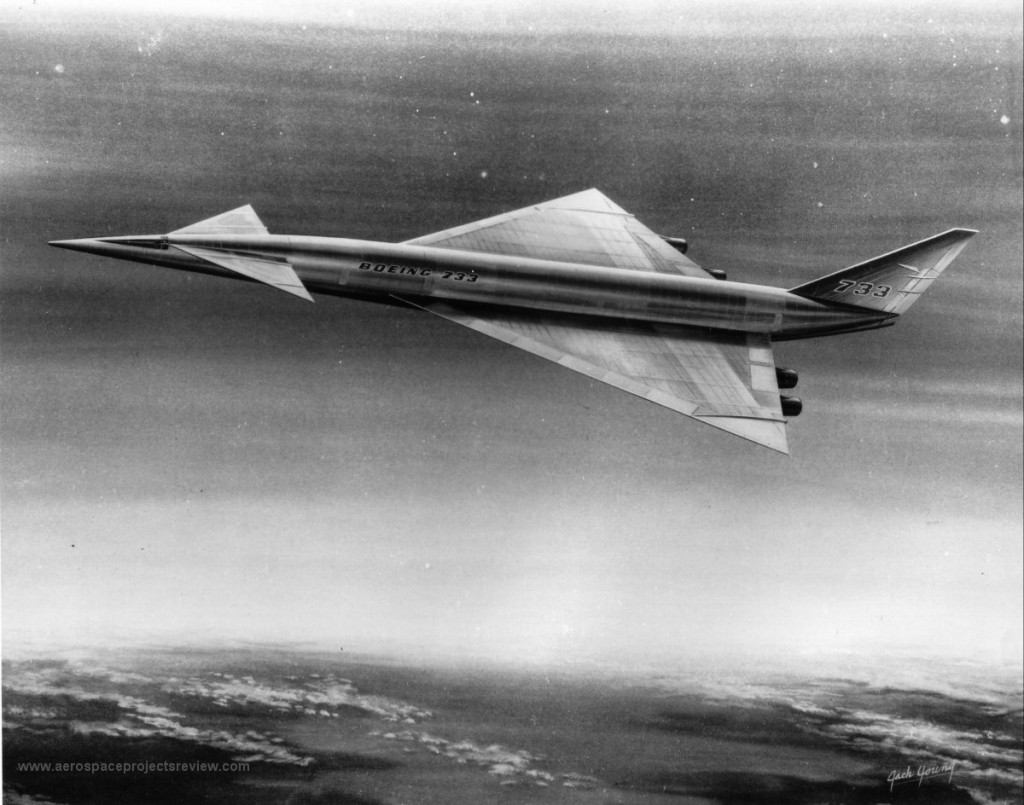
From the Fifth Semiannual Report to Congress (NASA, 1961) comes a photo of a supersonic transport wind tunnel model. This configuration would have been quite difficult to translate into a practical airliner design; while the dedication to area ruling would have made it quite low drag at supersonic, it would have made manufacturing a nightmare. Additionally, the severe wasp-waisting of the fuselage would have made not only the structural design of the pressure vessel a challenge, it would have made the passenger seating layout quite a mess.
This card shows an early (late 1980’s) McDonnell-Douglas design for NASP. A relatively fat lifting body design, this has many similarities to hypothetical “Aurora” hypersonic spyplane designs bandied about at the same time. This is not surprising… this NASP design is similar to any of a number of hypersonic configurations tested in NASA wind tunnels and shown publicly.
Note that the text on the back of the card describes a vehicle somewhat different than what NASP was supposed to be. The claim is made that the scramjets could power the vehicle Mach 25, orbital velocity… of they could allow the vehicle to cruise at Mach 6 for long range hypersonic transport. Early on in the program, the “Orient Express” was touted as a logical result of NASP work, but that quickly faded.
You can download 5.3 and 2.5 megabyte JPG files of the illustrations. The links to the JPG files are HERE and HERE. To access them, you will need to enter a username and password. The username: the first word in the body of the text on page 5 of APR issue V1N1. The password: the first word in the body of the text on page 11 of the same issue. Note that both are case sensitive.
In 1960, Bell Aircraft released several paintings depicting a two-stage hypersonic passenger transport. The first stage was a multi-engined supersonic jet of fairly conventional configuration (though with very large 50,000 lb-thrust turboramjet engines), carrying on its back a rocket-powered second stage. The second stage was clearly influenced by Bell work on the Dyna Soar program.
The carrier would transport the second stage to an altitude of 20 miles and 5,300 mph. After release, the second stage would boost to 40 miles and speeds up to 15,000 miles per hour, permitting travel times from Los Angeles to Paris of one hour and four minutes for the thirty passengers on board. The vehicle was intended to enter service in the 1980-1990 timeframe.
Weight for the combined vehicle at takeoff would be 750,000 pounds. Span of the booster was 150 feet, length 200 feet. It’s unclear if this was a serious engineering design or purely speculative. Paintings and a display model show some notable differences.
You can download a 3 megabyte JPG file of the artwork; the link is HERE. To access it, you will need to enter a username and password. The username: the first word in the body of the text on page 6 of APR issue V1N3. The password: the first word in the body of the text on page 23 of the same issue. Note that both are case sensitive.
NG has recently unveiled their concepts for next generation jetliners under the NASA “Environmentally Responsible Aviation” program. NG is not known for airliners, but rather military vehicles… most famously the B-2 stealth bomber. Not surprisingly, their jetliner concept looks a whole lot like a stealthy flying wing bomber. It seems a reasonable suspicion that their work under NASA contract either makes use of existing military design work… or will form the basis of future military design work.
Since the Northrop Grumman ERA N+2 design is revolutionary (at least in terms of airliner design), they have produced a design of a Subscale Test Vehicle. At 143-foot span, it’s about 60% the size of the passenger version and 55% the size of the cargo carrying final version.
The STV would seem to be sized right for a bomber, while the passenger and cargo carrying version would be rather large… more sized for arsenal aircraft, loaded with a vast number of cruise missiles and the like.
Conceptual artwork from 1967 depicting a Mach 10 to Mach 14 hypersonic transport. Hydrogen burning scramjets would provide cruise propulsion at an altitude of 110,000 to 140,000 feet. No further data is available apart from what can be determined from the artwork. There are 136 seats, relatively few for an aircraft that is clearly quite large. The general configuration is similar to the hypersonic testbed previously posted HERE, especially the propulsion system & inlet arrangement.
You can download a 9.7 megabyte JPG file of the artwork; the link is HERE. To access it, you will need to enter a username and password. The username and password are listed on page 2 of APR issue V0N0. Note that both are case sensitive.
Downloading FAQ
I keep getting asked the same questions, so I guess I should have a Frequently Asked Questions page for my downloads. Well, here it is.
Q01: How does this work?
A: It’s not an automated system. The way it works is that when you place an order through Paypal, Paypal sends me an email notifying me of the order. I then reply to the email address listed in the order, providing you with the web address where you can find your document, plus the username and password you’ll need in order to access it.
————–
Q02: “I just ordered a document. It’s been a whole 2 seconds, and I don’t have it yet. Where is it?”
A: I’m asleep/out buying groceries/fighting off hordes of zombies. I’ll respond to your email just as soon as I can.
————–
Q03: “I just ordered a document. It’s been a whole 24 hours, and I don’t have it yet. Where is it?”
A1: Check your “spam bucket.” Some spam filters see response messages such as you’ll get from me as spam, since there is a web address listed in it.
A2: Are you using the email address attached to the Paypal account? The response email with all your download info will be sent to the Paypal-listed email address. If you are using someone else’s Paypal address, or something like that, then *they* will receive the reply.
A3: On rare occasion, the automated Paypal system that sends me order notifications fails to do so. Thus I don’t know you’ve ordered something. Feel free to send a “where’s my stuff” email to: ![]()
A4: Search your inbox. You might have gotten the message, but not noticed or recognized it. The header will be something like “Re: Notification of payment received” or “Re: Payment received from YourEmail@YourEmailDomain.com.”
————–
Q04: “I ordered a document for downloading, but the username and password aren’t working.”
A: By far the most common reason for this is either you’re typing the password wrong… or if you are using cut-and-paste, you are grabbing a spurious blank space. Try again, making sure to cut *just* the password.
————–
Q05: “I tried that, but it’s still not letting me in.”
A: The second biggest offender is your web browser. Something or other to do with cookies, or something. If you have another web browser (Netscape, Explorer, Firefox, whatever), try that.
————–
Q06: “I’ve downloaded a PDF file. What do I need to open it?”
A: Adobe Reader. It’s a free program.
————–
Q07: “I’ve downloaded a ZIP file. What do I need to open it?”
A: Any modern computer should have come with an unzipping program built in. If not, do a search for “unzip,” and download a program to your liking.
————–
Q08: “I ordered a drawing set, and can see the files named ‘XYZ halfsize.gif’ and ‘XYZ quartersize.gif,” but not the full size image. Why?”
A: Some of the full size images are quite large. Sometimes they are so large that operating systems and/or image viewing and processing programs simply refuse to show them. All of the full-size images I sell are viewable on *my* system, which is a bit antiquated… but that doesn’t mean that they will be viewable on *all* systems. This is why I include the “halfsize” and “quartersize” versions, so that everybody should be able to see the images. You do still have the full-rez image… try looking at it on another computer.
————–
Q09: “Ooops, I ordered the wrong thing. I wanted A, but I seem to have actually ordered B. Can I have A?”
A1: If the error is due to something screwy in the webpage – rare, but it has happened that a typo in the HTML coding can lead to this sort of thing – then I’ll fix you right up with a proper download of A. Keep the other item, free of charge.
A2: A slightly more common error is on my part… you order SDOC4, say, and I mistakenly send you the link to SDWG4. In that case, let me know, and I’ll fix you right up with what you actually ordered. Keep the other item, free of charge.
A3: If the error is due to you simply ordering the wrong thing… well… the problem with digital files is that you can easily make copies of them, and thus cannot really be returned. So if my policy was to automatically “correct” “mistakes,” then it’d be the easiest thing in the world to scam me right out of half my catalog.
So… no. If you wanted A but mistakenly ordered B, I’ll be happy to fill your *next* order for A.
————–
Q10: “I bought one of your documents, and want to extract the images from it for my own devious purposes. However, it’s password protected. Gimme the password. Gimme.”
A: The documents (air docs, space docs and APr’s, but not DCD’s) are password protected *solely* to try to minimise piracy of ’em. The documents will open just fine and will print just fine at high rez, but image and text extraction will present a challenge. I’ve had issues with people taking the data I’ve worked hard to find and prepare and then turning it around and reselling it (grrr). However, if you have a valid use for extracted images, let me know, and I’ll almost certainly fork over the relevant password.
————–
Q11: “I want you to add me to your mailing list.”
A: No can do. The system I use now requires that the person who wants on the mailing list add themselves (I can add you, or the system will think I’m a spammer). So, simply go HERE and add your email address.
I’ll update this FAQ as questions come in. Feel free to comment
